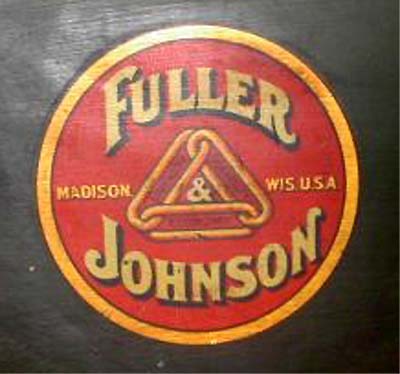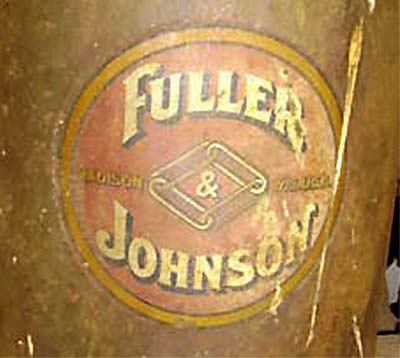

ENGINE COLORS
The Fuller & Johnson Mfg. Co. painted their
engines in 3 different colors. Almost all engines built were green but
the early oil cooled engines were red. A dark red like DuPont's Centari
#51078A is a good match. All hopper cooled engines and a very few of the
late oil cooled engines were green. "Dark Machinery Green" is quoted in
several original catalogs. Due to the technology at the time, the color
varied slightly from one batch of paint to the next. An excellent match
can be made by mixing 1 quart of Rust-Oleum #7738 Hunter Green with 7
ounces of flat black. For years DuPont's Centari #7666A has been listed
as a match but I've never seen a paint chip and cannot comment on how
accurate it is. Starting around 1919 a new shade of green was introduced
and used on all further engines. It is somewhat similar to the later
Hercules green, being a yellow/grass green in color. To date I've not
found a good color match but will update this section when I do.
Farm Pump Engines, Multimotors and JA engines were also painted green same as the hopper cooled engines . The cylinder, cylinder head, rocker arm and its bracket, valve keepers, push rod and auxiliary exhaust port muffler should be painted in a heat resistant aluminum color. Some engines were a gloss black instead of green, but this was not often. All parts painted in aluminum apply to these engines as well. JW and water cooled Farm Pump Engines were completely green.
Light plant engines appear to have painted green as well. Those sold by Fuller & Johnson had the appropriate tag and decal affixed. For the ones being sold by Western Electric the green was painted over with a black similar to that applied to a new Ford model T and the Western Electric tags installed.
Information on the color of radiator cooled engines is hard to come by. From previous factory practice it would seem that engines being sold by Fuller & Johnson were all green. However I have run across engines that came off various mixers and bailers that were machinery gray from the factory. It is possible that Fuller & Johnson custom painted engines going to machinery manufacturers.
A good number of engines were shipped from the factory on wood skids. These skids were red, Rust-Oleum #7762 is a good match. If the engine was on a cart this was painted red as well with jet black wheels and running gear. If a wood battery box was supplied this would have been red with BATTERY stenciled across the front in black.
Many engine manufactures striped their engines to make them more attractive to potential buyers. While not as elaborate as other firms, Fuller & Johnson did stripe their engines. The pattern used was not consistent and many late engines, as well as early ones had no striping at all. The majority had their hopper and base outlined, there was no definite design to the striping so check photos on this site to get some ideas. The flywheels could have had one of several observed patterns on each spoke, or two bands going completely around the spoke near where the spoke meets the rim. The rims were bare metal. Larger engines often had some design on top surface of cylinder head. The mixers of N kerosene or model K engines could have also been outlined, depending on whoever was striping engines that day. A bright yellow such as Rust-Oleum #7745 will do fine for the striping. On Farm Pump Engines, the raised flywheel lettering as well as the operational rotation arrow were yellow as well. Some early plain flywheel pump engines have been observed with a white rotation arrow. No other striping was used on these engines. Model N, NB, NC and ND engines used on cement mixers had iron channels which were the same green as the engine. Model NC and ND engines had their steel skids green as well.
Fuller & Johnson engines had a large, attractive decal on either side of the hopper. Usually, this was centered on the hopper. Engines using the Wico magneto had the decal offset on the magneto side only. Early engines did not use a decal although some DE engines and People's Priced had "Fuller & Johnson" printed across the hopper in either black or yellow. So far I have determined that two different size decals were used. 1 1/2, 3 and 5 hp engines used a decal that was 4" in diameter. Engines 7 to 25 hp used a decal that was 5 1/2" in diameter. During the later 20's a new decal with 4 links was introduced. Most engines had a decal on each side of the hopper. If a Wico EK magneto was fitted the decal on that side of engine was moved back a bit to make it more visible. A few late NC, ND and NK engines had only a single decal placed on the front of hopper face.

Amazingly well preserved original 3 link decal

Late style 4 link decal as seen on a F&J tagged light plant engine
Farm Pump Engines, Multimotors and JA engines were also painted green same as the hopper cooled engines . The cylinder, cylinder head, rocker arm and its bracket, valve keepers, push rod and auxiliary exhaust port muffler should be painted in a heat resistant aluminum color. Some engines were a gloss black instead of green, but this was not often. All parts painted in aluminum apply to these engines as well. JW and water cooled Farm Pump Engines were completely green.
Light plant engines appear to have painted green as well. Those sold by Fuller & Johnson had the appropriate tag and decal affixed. For the ones being sold by Western Electric the green was painted over with a black similar to that applied to a new Ford model T and the Western Electric tags installed.
Information on the color of radiator cooled engines is hard to come by. From previous factory practice it would seem that engines being sold by Fuller & Johnson were all green. However I have run across engines that came off various mixers and bailers that were machinery gray from the factory. It is possible that Fuller & Johnson custom painted engines going to machinery manufacturers.
A good number of engines were shipped from the factory on wood skids. These skids were red, Rust-Oleum #7762 is a good match. If the engine was on a cart this was painted red as well with jet black wheels and running gear. If a wood battery box was supplied this would have been red with BATTERY stenciled across the front in black.
Many engine manufactures striped their engines to make them more attractive to potential buyers. While not as elaborate as other firms, Fuller & Johnson did stripe their engines. The pattern used was not consistent and many late engines, as well as early ones had no striping at all. The majority had their hopper and base outlined, there was no definite design to the striping so check photos on this site to get some ideas. The flywheels could have had one of several observed patterns on each spoke, or two bands going completely around the spoke near where the spoke meets the rim. The rims were bare metal. Larger engines often had some design on top surface of cylinder head. The mixers of N kerosene or model K engines could have also been outlined, depending on whoever was striping engines that day. A bright yellow such as Rust-Oleum #7745 will do fine for the striping. On Farm Pump Engines, the raised flywheel lettering as well as the operational rotation arrow were yellow as well. Some early plain flywheel pump engines have been observed with a white rotation arrow. No other striping was used on these engines. Model N, NB, NC and ND engines used on cement mixers had iron channels which were the same green as the engine. Model NC and ND engines had their steel skids green as well.
Fuller & Johnson engines had a large, attractive decal on either side of the hopper. Usually, this was centered on the hopper. Engines using the Wico magneto had the decal offset on the magneto side only. Early engines did not use a decal although some DE engines and People's Priced had "Fuller & Johnson" printed across the hopper in either black or yellow. So far I have determined that two different size decals were used. 1 1/2, 3 and 5 hp engines used a decal that was 4" in diameter. Engines 7 to 25 hp used a decal that was 5 1/2" in diameter. During the later 20's a new decal with 4 links was introduced. Most engines had a decal on each side of the hopper. If a Wico EK magneto was fitted the decal on that side of engine was moved back a bit to make it more visible. A few late NC, ND and NK engines had only a single decal placed on the front of hopper face.

Amazingly well preserved original 3 link decal

Late style 4 link decal as seen on a F&J tagged light plant engine